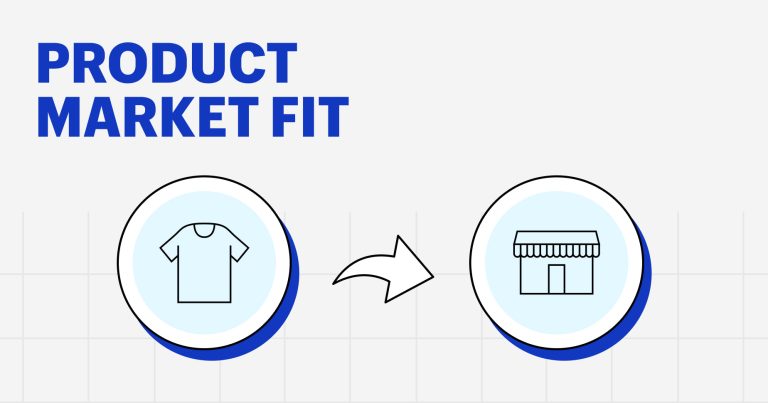Achieving product-market fit means that you have a strong value proposition, people find out about your store by word of mouth, you have a steady stream of customers and sales, and that your product solves a problem within a larger, lucrative market.
Here, we’ll cover what product-market fit is, how to prove your product concept, and how to use marketing and customer feedback to determine product-market fit.
What is product-market fit?
The Lean Startup summarizes Marc Andreessen’s definition of product-market fit as “the moment when a startup finally finds a widespread set of customers that resonate with its product.”
Finding product-market fit doesn’t necessarily provide an aha moment, but you can think of it as when the interest from customers validates that your product satisfies a need or solves a problem.
Why is it important to achieve product-market fit?
The reason it’s important for you to find product-market fit for your business is that it’s an early indicator of success. Businesses that achieve product-market fit can use organic marketing or word of mouth to increase their customer base and sales. Businesses that don’t achieve product-market fit need to rely heavily on paid advertising (which costs a lot of money), and can easily get stuck in a cycle of slow or limited growth.
As you set out to find product-market fit, expert Andrew Chen recommends starting with an exercise. The first step? Picture a coffee cup. Unsplash
How to find product-market fit
Achieving product-market fit is a process. And while it’s not always a linear one for small businesses just getting started, these steps will help you figure out more about your core value proposition and who your target customer is, and help you do some essential market research. At the end, you should have the tools you need to find product-market fit.
1. Start with a simple visualization exercise
Finding product-market fit is a process, and it’s not always clear where to start.
That’s why we chatted with expert Andrew Chen, general partner at Andreessen Horowitz, and author of The Cold Start Problem, to get his take on how to find product-market fit.
To better understand how achieving product market fit works, Andrew recommends imagining a simple coffee cup. A coffee cup is an item that’s achieved product market fit because it’s in a well-defined, existing product category. You know, Andrew says, the features that people expect and want, and the problem business owners have to wrestle with are differentiation and distribution, not product-market fit.
In contrast, for unique product ideas, it takes longer to find the exact version of the product that gets you to product-market fit. As you begin the process of finding product-market fit, Andrew suggests that you simplify your product idea, compare that version with your current plan, and find a version that exists between the two that your target customer will understand.
“The difficulty of product-market fit,” Andrew says, “exists on a spectrum—with maximum difficulty products that are completely new at one extreme, and undifferentiated but well understood products on the other.”
2. Understand the importance of a good market vs. a good product
Finding product-market fit often means identifying a good market (one that is large and has demand) and molding your product to fit the needs of that market. You could build the best product that solves multiple pain points for customers—but if there’s no market to support it, or the market is weak, your product will fail.
That’s why it’s essential to use the market as a way to shape and develop your product.
“You mold your product to fit a market by listening to the market,” says Elad Burko, founder and CEO of successful business Paperwallet. “Listen to your customers. Take your product to the customer, try to sell it to them. Understand what’s important to them, what’s not important to them. … If there are features in your product that the customer doesn’t care about, get rid of them.”
Parade has found product-market fit with a business that aims to “rewrite the American underwear story.” Parade
Sustainable underwear brand Parade is a good example of how a great product idea and a strong market can work together to build a successful business.
The underwear market is always going to be around. And it has extensive fundamental issues—many companies don’t make underwear in plus sizes, and use packaging and materials that are bad for the environment, to name a few. Parade identified those issues and uses its products to solve pain points for its customers. Its underwear comes in sizes from XS to 3XL, is made in sustainable fabrics, and ships in sustainable packaging.
Parade’s founder identified a great market and delivered a product that aims to solve a few fundamental needs. In doing so, Parade has reached a devoted customer base that has fueled its success.
3. Prove your product concept
So you have a product idea. Before developing a minimum viable product (MVP) that you can share with your audience, Andrew recommends asking some tough questions.“How do you pick a set of features that give the proper ‘twist’ that exists between two extremes?” he asks. “How do you dial down your fancy new concept and take a few small steps—but not all the way—toward something that consumers already understand?”
Essentially, what Andrew asks is how to introduce a product that is just revolutionary enough but not so much that consumers can’t understand it. Peloton’s upgraded stationary bike is a great example of making small tweaks to an existing item that create a big impact.
After you consider those questions and create the first iteration or MVP of your product, the second step to achieving product-market fit is to actually prove that your product is something customers want to buy. Sounds simple, but until you get your first few sales, you won’t be able to get feedback, which limits your ability to know how you’re doing or what changes you can make to improve.
Nimi Kular, co-founder of Jaswant’s Kitchen, a business that sells all-natural Indian seasonings, says that the best way to validate your product is to start making sales. “Market research, surveys, and feedback from friends and family can point you in the right direction,” says Nimi, “but real product validation only happens when money changes hands. For us, that happened at the first few shows we went to, where complete strangers bought our product. That’s when we knew we were fulfilling a genuine need with a product people would pay for.”
Starting to get real sales can also help you figure out what kind of business model does and doesn’t work for you.
Real sales aren’t the only way to prove that a product will be lucrative, though. Here are a few other ways to do it.
Free Guide: How to Find a Profitable Product to Sell Online
Excited about starting a business, but not sure where to start? This free, comprehensive guide will teach you how to find great, newly trending products with high sales potential.
Get the free guide
Get How To Find A Product To Sell Online: The Definitive Guide PDF delivered right to your inbox.
Almost there: please enter your email below to gain instant access.
We’ll also send you updates on new educational guides and success stories from the Shopify newsletter. We hate SPAM and promise to keep your email address safe.
Thanks for subscribing. You’ll start receiving free tips and resources soon. In the meantime, start building your store with a free 3-day trial of Shopify.
Get started
Use Kickstarter to establish proof of concept
Kickstarter provides a built-in audience already interested in supporting new product ideas. It creates a low barrier to entry to try out your idea and see how the market responds.
Elad Burko, CEO of Paperwallet, recommends putting up your products on Kickstarter to test your market. Even if your product fails this time, you’ll gain a loyal base of backers to help you get it right—which may just mean changing up your marketing messaging.
“It was an amazing way to connect to people who are passionate about what you’re doing with your product,” says Burko. People who are “willing to give you the feedback that you need, be it positive or negative. You interact with them so that you can grow so that you can improve. And that’s invaluable to a business.”
💡 Tip: Kickstarter is a great way to find and connect with your target audience early on and identify the people who are willing to work with you and spend the time giving you real feedback.
Validate product ideas with organic marketing
The founders of Pantee, a sustainable fashion brand that upcycles deadstock t-shirts into underwear, used Instagram to validate product ideas at the very beginning.
When Pantee had around 400 Instagram followers, the founders sent out direct messages via Typeform that asked questions about favorite underwear styles, how much people were willing to pay for underwear, and how they felt about sustainability. The 200 responses they received helped drive product decisions, as the team was still developing samples.
Co-founder Amanda McCourt says that she and her sister used Instagram to do “a lot of community engagement. We didn’t just post one thing, we actually engaged with our audience. We spoke to them, listened to what they’re talking about, and what they liked. We did a lot of that and it really has paid off.”
Using organic marketing channels is free, and it’s a great way to start building an engaged audience early on. If you’re still in the product development phase or you’re trying to prove the concept, consider creating a social media account on whichever channel feels better for your brand before your products (or even your official website) is ready. It’ll give you a direct line to your target customer base who will be most likely to purchase your products in the future.
💡 Tip: Build a social media presence early on so you can ask your target audience directly for feedback during the product development phase.
Analyze product effectiveness with jobs to be done
Use the jobs-to-be-done framework to better understand if your product solves a problem for your customers. Think about it this way: Customers “hire” your product to do a job. You might hire a leash to keep your dog close on walks, or hire an umbrella to keep you dry in the rain. These products fulfill a need. It’s less about what you purchase a product to do (I’m going to use this hammer to put a nail in the wall) and more about the result (I’m hiring this hammer to help me put up this piece of art).
As the original authors of the framework wrote, “By mapping out every step of the job and locating opportunities for innovative solutions, companies can discover new ways to differentiate their offerings.” When you pivot to think about the end result, the usefulness of an item becomes more clear.
💡 Tip: As you develop your product and think about proving its concept, ask: What job might customers hire your product for?
4. Use customer feedback to mold your product to fit the market
Creating an open feedback loop with your customers, especially at the beginning, is key to developing something your target audience will love early on. Those early customers are more likely to be invested in your product, more likely to stick with it while you work out the kinks, and more likely to provide honest feedback. They are the best people to lean on as you grow your business, so giving them an easy way to provide that feedback will make the process easier for everyone.
Creating an open feedback loop with your customers, especially at the beginning, is key to developing something your target audience will love early on.
Aaron Luo, CEO and co-founder of sport bag and accessory company Caraa, remembers his first 20 customers because of the amazing feedback they gave. The key was being transparent with those customers upfront that Caraa was a new business and that it wanted feedback.
Luo basically told customers, “Listen, we are an emerging brand. This is our story. This is what we’re trying to fix in the market space, and here are our products, and we welcome any feedback.”
💡 Tip: Be honest with your early customers, share your product mission, and be direct when you ask for feedback. Collect that feedback, look for trends, and use it as you further develop your product, positioning, and brand.
5. Properly position your product in the market to achieve product-market fit
Customer feedback also plays an essential role in the way you position your product. You could have a great product and a great market, but if your marketing messaging is off, sales will be as well.
Ultimately, you need to understand your target audience and the problem they need to solve. Elad Burko, CEO of Paperwallet, shares a good example of this during his interview with us on the Shopify podcast.
The message is not “This wallet is made of paper yet doesn’t rip.” It’s “This wallet is low profile, durable, water resistant, and will last a long time.” See the difference? The first message doesn’t actually offer a solution to a problem. The second message speaks to common issues customers might have with their current wallet.
There are multiple ways to get feedback on your marketing messaging. Here are a couple of options you can try:
Meet potential customers in person. Bring your product to farmers markets, trade shows, etc., and get feedback on how you’re presenting your products. Getting a lot or even a little interest is a great way to understand how you’re doing.
Use social media channels to gauge reception. Establishing a loyal customer base organically is a great way to get product feedback, but it’s also a free way to see how people respond to your product positioning, too.
A/B test different messaging on paid channels. Paid advertising allows you to test different types of messaging against each other to better understand what resonates with your target market.
6. Leave room for change
Even as you find product-market fit, what your customers need and the larger market is always going to be evolving. So, it’s important to keep those feedback loops open and to continue iterating on your product and messaging over time. That way, you’ll keep product-market fit even as the market changes or as your customers want different things.
And as change is constant, you should also measure product-market fit over time. This will clue you in on key insights that can help you make important product developments to keep your product up to date, useful, and relevant to your audience.
Start your free trial of Shopify—no credit card required!
Featured image by Jon Krause
Product-market fit FAQ
What does product-market fit mean?
Product-market fit is a term used to describe the degree to which a product meets the needs of a given market. It is a measure of how well a product satisfies its intended purpose and meets customer needs. Product-market fit can be achieved through a combination of product innovation, market understanding, customer feedback, and marketing efforts.
What is a good product-market fit score?
The answer to this question depends on the specific product and market in question. Generally speaking, a product-market fit score of 6 or higher is considered to be good, but this is not a hard and fast rule.
What is an example of product market fit?
One example of a product that has achieved product-market fit is the classic coffee cup. A coffee cup is an item that’s achieved product-market fit because it’s in a well-defined, existing product category. It’s clear which core features people expect and want.






0 Comments